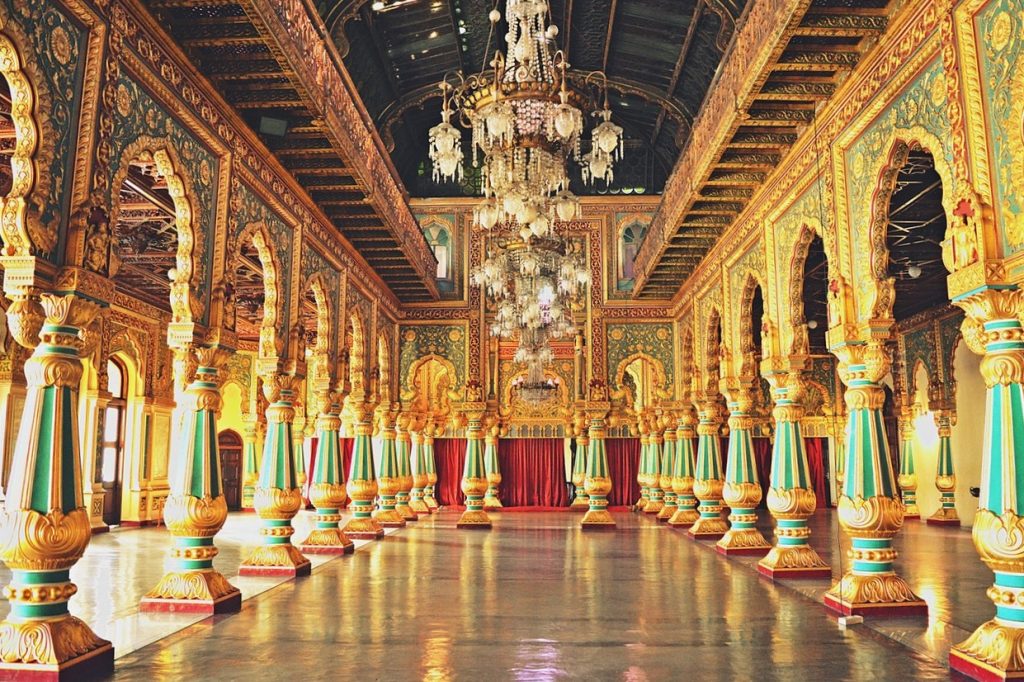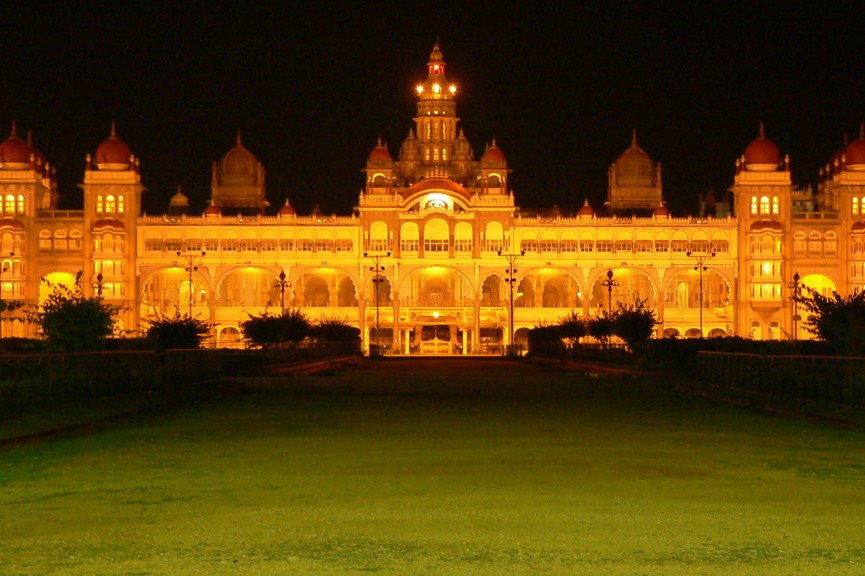History Of Mysore Palace: Home Of The Wadiyars
The first thing that comes to mind when one hears the word Mysore is the magnificent Mysore Palace. This heritage city of Karnataka is famous for its splendid palaces, sandalwood and silk, but the Mysore Palace’s beauty and splendour make it stand out. While the City of Palaces has seven different palaces, the one called Mysore Palace is the one located within the old fort. The Amba Vilas Palace, also known as Mysore Palace, was once the seat of the Kingdom of Mysore. Today, the grand home of the erstwhile rulers of Mysore is one of the most popular tourist attractions in India. Built and renovated over five centuries, the home of the Wadiyars is a treasure trove of historical artefacts. Let’s take a look at the history of Mysore Palace.
Also read: The fascinating history of the royals of the imperial city of Mysore, the Wodeyars
History Of Mysore Palace And Its Construction

The history of Mysore Palace and its construction and renovations over five centuries tells many tales of India’s complex and intriguing past.
The old fort or puragiri (citadel), as it was known earlier, faces eastwards towards Chamundi Temple. The first palace in the old fort was constructed by Yaduraya, the founder of the Wadiyar dynasty in the 14th century. Since then the palace has been demolished and reconstructed several times over the centuries. The construction of the old fort was completed in CE 1574 by Chamaraja Wadiyar IV, the seventh king of Mysore. But the palace was struck by lightning and destroyed, according to Shrimanmaharaja’s Vamshaavali (the history of the Mysore Royal family). Ranadheera Kanthirava Narasaraja Wadiyar, the twelfth king of the Mysore dynasty, rebuilt the palace in 1638.
However, the problems didn’t stop there. During the Islamic rule over Mysore, Tipu Sultan abandoned all pretence of owing allegiance to the Wadiyar Kings like his father Haider Ali had done. He destroyed several areas inside the palace walls in 1797 to make way for his new capital, Nazarbad. However, this didn’t last long as the fourth war of Mysore in 1799 spelt the end of Tipu Sultan and his reign. According to B. Lewis Rice, the author of the ‘Mysore Gazetteer’, when the victorious British and Wadiyars came back, there was not a single suitable house in Mysore. All that was left was an unfinished fort with large stones and boulders and hastily constructed workmen sheds. So the coronation of Nalwadi Krishnaraja Wadiyar III was conducted in one of the construction sheds in Nazarbad. The newly elected king resurrected the destroyed palace.
Construction Of The New Palace

However, another freak accident destroyed the palace in 1897, during the wedding of Princess Jayalakshammani. The old palace, also known as the Wooden Palace caught fire and burned down to ashes. The current structure that we know as the Mysore Palace was constructed between 1897 and 1912, after the old palace burnt down. The Queen Regent, Kempananjammanni Vani Vilasa Sannidhana and Maharaja Krishnaraja Wodeyar IV commissioned the British architect, Henry Irwin to build the new palace. P. Raghavulu Naidu, an executive engineer in the Mysore Palace division, oversaw the construction. The architect visited Delhi, Madras (now Chennai) and Calcutta (now Kolkata) and conducted elaborate architectural studies to design the new palace. The construction of the Mysore Palace was completed in 1912 and cost approximately 42 lakhs (approx $30 million adjusted to inflation).
Though the palace was completed, the fort continued to be renovated and beautified. In 1940, during the reign of Maharaja Jayachamarajendra Wadiyar the palace was further expanded. It was during this renovation that the present Darbar Hall wing was added.
Architectural Style

The entire palace is built using stone and marble in the Indo-Saracenic style. The architecture boasts a blend of Hindu, Mughal, Rajput and Gothic styles, due to its numerous renovations. The three-story stone structure has dark pink domes, turrets, expansive arches and colonnades and a large geometrically laid-out garden. The palace also has a five-story tower that is 145 feet high with a gold-plated dome. Two durbar halls (royal courts), courtyards, embellished mahogany gates and the royal family’s living quarters are also a part of the palace. The Mysore Palace also has 12 temples constructed during various periods by the Wadiyar kings.
The palace has four main entrances. The East gate, also known as Jaya Maarthaanda, is the front gate and only opened during Dasara and only for dignitaries. Similarly, Varaha, the West entrance is also opened only during Dasara festivities. The South entrance, called Balarama, is open to the general public. The North gate is called Jayarama. The Mysore kingdom’s emblem and coat of arms are inscribed on the entrance gate and arch.
The Wadiyar dynasty, being great patrons of fine arts, employed the finest craftsmen to work on the palace. One of the most notable works of art is the exquisite sculpture of the goddess Gajalakshmi (the goddess of good luck, prosperity and wealth) and her elephants that sits atop the central arch. The palace cellar is rumoured to have several secret tunnels, which lead to different palaces. One of these tunnels is rumoured to lead to Tipu Sultan’s Summer Palace in Srirangapatna.
Mysore Palace: A Treasure Trove Of Artefacts, Myths And Legends

As impressive as the structure and exteriors of the palace are, the interior is even more breathtaking. The vast Durbar Hall, the beautiful peacock-themed Kalyana mantapa (marriage pavilion), the doll’s pavilion and museum draw thousands of visitors annually. The ornately carved ceiling and beautifully sculpted and carved blue and gold pillars of the Durbar Hall are a sight to behold. The floral mandalas, the beautiful paintings of the Dasara procession and the stained glass windows are equally breathtaking. The painting of the Dasara procession is painted in a way that it seems to move towards the viewers, wherever they stand.
The museum houses solid silver doors, the sword of Tipu Sultan, several paintings by Raja Ravi Varma, weapons, and cannons. Also on display are several chandeliers, imported from Czechoslovakia. The main attractions, however, are the wooden elephant howdah decorated with 84 kgs of gold and the Chinnada Simhasana (golden throne). The jewel-encrusted, golden throne of the Mysore Royals, which originally belonged to the Vijayanagar kings, is said to have once belonged to the Pandavas.
Also read: 15 magnificent royal palaces in India you must see
Keeping Tradition Alive
The palace and its inhabitants still play a pivotal role in the life of Kannadigas, especially the people of Mysore. The Royals of Mysore and their people have a long tradition of celebrating the Dasara festival with great pomp and grandeur. The annual Dasara celebration, also known as the nadahabba (festival of the state) is when the Mysore Palace comes alive. The festivities observed for ten days include a special durbar (royal assembly). During the durbar, the reigning king grants an audience to members of the royal family, special invitees, officials and the masses.
The palace hosts athletic competitions, music and dance concerts through the 10 days of the Dasara festival. On Vijayadashami, the tenth day, a procession of decorated elephants, called the Jumbo Savari is held on the streets of Mysore. The lead elephant carries an idol of the goddess Chamundeshwari inside a golden howdah. The procession also includes colourful tableaux, dance groups, tribal artists, music bands, decorated horses and camels. The Jumbo Savari culminates at Bannimantap with a puja to worship the banni tree (prosopis spicigera). A torchlight parade is conducted at the Bannimantap Parade Grounds after the Jumbo Savari. While the Jumbo Savari, the Dasara exhibition, and other events are beautiful, the sight of the Mysore Palace lit by 97,000 light bulbs is the one that will take your breath away.
The history of Mysore Palace has been an eventful and interesting one. The palace has stood the test of time and still stands tall today. Every wall and pillar here has a story to tell. And it is on us to preserve this magnificent monument from the past for generations to come.
from Travel.Earth https://ift.tt/3jgbsof

0 Comments